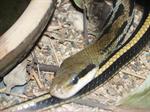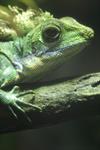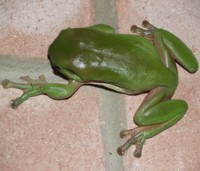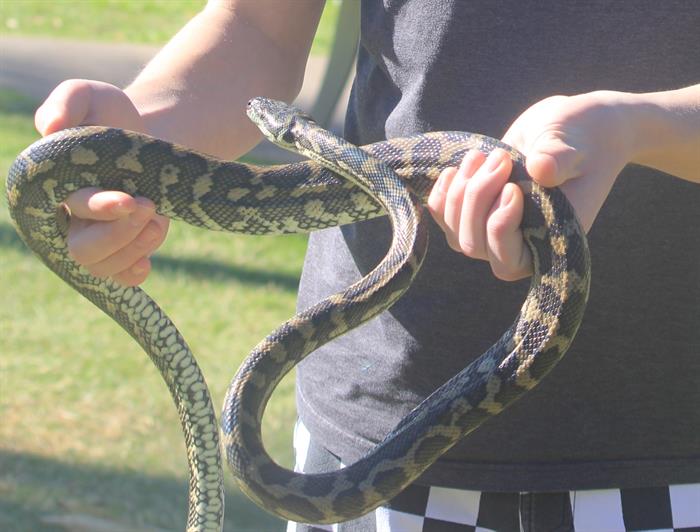
LEARN ABOUT REPTILES & AMPHIBIANS
- Indulge a passion, or
- Work with them
The scope for working with amphibians and reptiles may be larger than you think.
People work with these animals in the wild (conservation), in zoos, captive breeding programs, research, through to pet shops and keeping them as pets.
Lesson Structure
 Lesson 1. Introduction to Herpetology
Lesson 1. Introduction to Herpetology
- Herpetology Defined
- Introduction to Reptiles
- Animal Taxonomy
- Classification of Reptiles
- Characteristics of Reptiles
- Testudine Characteristics (Turtles)
- Squamata Characteristics (Snakes and Lizards)
- Rhynchocephalia Characteristics (Tuatara)
- Classification of Amphibians
- Amphibian Characteristics
- Building Resources and Developing Networks
- Terminology
Lesson 2 Class Reptilia (Reptiles)
- Reptile Classification
- Water Conservation
- Reproduction
- Order Chelonia (Testudines) – Turtles
- Order Crocodilia – Crocodilians
- Order Squamata
- Scaled Reptiles - Lizards (Suborder Sauria) and Snakes (Suborder Serpentes
Lesson 3. Reptile Biology
- Reptile Anatomy
- Skeleton
- Scales and Skutes
- Ectothermal Regulation
- Coloration
- Respiration and Metabolism
- Food and Digestion
- Senses
- Locomotion
Lesson 4. Class Amphibia (Amphibians)
- Order Anura (Frogs and Toads)
- Order Apoda (Caecilians)
- Order Urodela (Salamanders and Newts)
Lesson 5. Amphibian Biology
- Amphibian Skeleton
- Skin
- Ectothermal Regulation
- Colouration
- Respiration and Metabolism
- Branchial
- Buccopharyngeal
- Cutaneous
- Pulmonic
- Food and Digestion
- Senses
- Locomotion
- Reproduction
Lesson 6. Ecology of Reptiles
- Introduction
%202005johnJuly%20Currumbin%20SanctuaryGreek%20022.jpg)
- Constriction
- Injected Venom
- Inertia Feeding
- Biting and Grasping
- Suction Feeding
- Reproductive Strategies
- Viviparity
- Oviparity
- Nest Building
- Habitat Use -Aquatic and Terrestrial
- Basking
- Hibernation
Lesson 7. Ecology of Amphibians
- Use of Habitat
- Temperature Relationships
- Feeding
- Vocal Communication - Advertisement calls, Territorial calls, Release calls, Distress calls
- Social Behaviour
- Dealing with Predators
- Reproduction and Parental Care
Lesson 8. Conservation Issues
- Habitat change
- Edge Effects
- Pollution – especially water pollution
- Environmental Acidification (Acid Rain)
- Pesticides
- Endocrine Disrupting Chemicals
- Spread of disease
- Invasive Species
- Climate Change
- Spread of Disease
- Disease in Wild Populations
- Trade in Reptiles and Amphibians
- Conservation
- Conservation Genetics
- Endocrine Disrupting Chemicals
Lesson 9. Keeping Reptiles and Amphibians
- Introduction
- Legal Issues
- Special conditions for Amphibians
- Special Conditions for Reptiles
- Preventing Spread of Disease from Reptiles to Humans
- Housing
- Reptile Captivity Problems
- Reptile Feed and Feeding
- Amphibians and Reptile Species that are in Captivity
- Feeding Amphibians
- General Care
- Common Ailments in Reptiles and Amphibians
- Parasitic Diseases
- Fungal Diseases
- Viral Diseases
- Metabolic Bone Disease
- Thiamine Deficiency
Lesson Aims
- Discuss the nature and scope of reptiles.
- Identify credible resources, and begin to develop networking with organisations and individuals involved with the study of reptiles around the world.
- Describe a range of different reptile species, including distinguishing characteristics, their needs (eg. environmental, food, etc) and behaviour.
- Identify and explain the anatomy and physiology of reptiles
- Discuss the nature and scope of amphibians
- Identify credible resources, and begin to develop networking with organisations and individuals involved with the study of amphibians around the world.
- Discuss the nature and scope of amphibians
- Identify credible resources, and begin to develop networking with organisations and individuals involved with the study of amphibians around the world.
- Describe the ecological requirements, reproduction and life cycles of amphibians
- Describe the behaviour of a range of different amphibian species.
- Explain conservation issues that are impacting upon populations of reptiles and amphibians.
- Explain the management of reptiles and amphibians in captivity
CARING FOR SICK REPTILES AND AMPHIBIANS
It is essential to ensure a clean environment with fresh, appetizing food, and clean water. Proper temperature and humidity are essential. It is often advisable to raise the temperature slightly to increase the animals metabolism, thus stimulating a more rapid effect of medications. Always consult a professional when your animal is sick to determine the appropriate treatment. You can often obtain advice from zoos or wildlife parks.
Common Ailments of Captive Animals
REPTILES
Acute Stress Syndrome
 Signs are dilation of the pupil, loss of righting reflex, with terminal convulsions & death. This situation is common in animals placed in a new situation or environment. Oral glucose at 3 grams per kg of body weight will help, but the causative agent should be removed, whether it is competition from other animals, a high population density, or something else. Force feed until well.
Signs are dilation of the pupil, loss of righting reflex, with terminal convulsions & death. This situation is common in animals placed in a new situation or environment. Oral glucose at 3 grams per kg of body weight will help, but the causative agent should be removed, whether it is competition from other animals, a high population density, or something else. Force feed until well.
Blister Disease
This can be caused by excessive humidity. Skin blisters appear at first, then become infected and filled with pus. Excise the blisters, flush with 50% peroxide and water, then swab with iodine. Do this daily, usually for 4 days.
Canker, Mouth Rot, Necrotic Stomatitis
This is a very common condition in snakes, lizards and tortoises. Initially there is redness and swelling of the membranes in the mouth. Marked swelling occurs, and death by suffocation is possible. As the disease progress there is continued inflammation, ulceration and increasing quantities of dead, peeled skin. The infection may spread to the bones of the jaw, causing osteomyelitis. Further spreading of the disease may cause pneumonia, gastrointestinal infection, or septicaemia. Vitamin C deficiency is a factor in this disease.
Treatment involves flushing the area with 50% peroxide and water, then gently removing all dead tissues. After this, rinse the area with a saline solution, then apply topical sulphadimidine or chloramphenicol. Give 10 milligrams of Vitamin C orally daily, and injections of multi vitamins twice weekly. Use antibiotics for about 8 days or more. Increase the room temperature to 32oC. Do not attempt to feed the reptile.
Cannibalism
This sometimes occurs as a result of overcrowding, or if there is no supervision during feeding. It may also occur if the wrong species are kept together. Lizards are the most likely to do this if animals of greatly different sizes are housed together. Fights are also relatively common between snakes, particularly when feeding.
PARASITIC DISEASES
These are most commonly found in urban reptiles rather than captive reptiles.
External Parasites (Ectoparasites)
Many parasites infest reptiles and with these come viruses, bacteria, haemoprotozoa and microfilaria. Mites are often found between scales on the head and neck of many reptiles. They usually require a treatment with parasiticides or environmental decontamination to be eliminated. Ticks on reptiles can result in anaemia. Manual removal is the best method of treating ticks.
Internal Parasites (Endoparasites)
Gastric roundworm (Strongylurus paronai) is known to infest bluetongue lizards, frilled lizards and water dragons. Cryptosporidia spp. (coccidian parasites) have been found in Red-Bellied Black Snakes, Pythons, Taipans and Tiger Snakes. The main symptoms of an infestation are gastritis, weight loss, regurgitation of food and sometimes death. Unfortunately there is no effective treatment for cryptosporidiosis at present.
Zoonosis (Infectious diseases)
Salmonella spp can be found in captive and wild, diseased and healthy reptiles. Incubation period can vary greatly, but typically animals shed the bacteria during times of stress. Clinical signs of Salmonella include pneumonia, coelomitis (of the yolk), hypvolemic shock (severe blood and fluid loss), abscesses and osteomyelitis (bone infection). Very young and older reptiles are more susceptible to developing clinical signs of infection.
AMPHIBIANS
 FUNGAL DISEASES
FUNGAL DISEASES
Chromomycosis
Chromomycosis is caused by various types of coloured fungi found in organic substances such as decaying vegetation. These can live on the walls of the tank and when an amphibian has a cut or sore it can be at risk of infection. Signs of infection include loss of appetite, weight loss, inflamed wounds that are unable to heal and possible neurological impairment. Antifungal drugs can be given for amphibians confirmed to have the disease. However, the best treatment is prevention, by improving sanitation in the tank.
Chytridiomycosis
As mentioned above, the Chytrid fungus is highly contagious and can be fatal to both pet and wild amphibians. It is the most serious of the fungal infections and attacks the keratin of the skin. It can survive in a range of environments, with or without a host. Signs of infection include loss of appetite, lethargy, excessive skin shedding, pupil constriction and lack of coordination. Many infections lead to death of the animal. If you suspect an amphibian to have the disease, it is important to immediately contact a veterinary expert. As the disease is highly transmissible it can infect all animals in a tank within days.
Saprolegniasis
This disease is caused by the water mould fungi. These infect the skin and gills of aquatic and young amphibians. Saprolegniasis is commonly seen in newts, mudpuppies, aquatic frogs and tadpoles. The infection appears as a white cotton-like growth on the skin. The growth may turn green over time due to the presence of algae. Other signs include lethargy, respiratory difficulties, weight loss and lack of appetite. Expert veterinarian inspection is required to diagnose the disease. The disease is usually treated by a medicated dip. This should carried out in conjunction with frequent water changes and providing a constant temperature for the animal.
PARASTIC DISEASES
Rhabdiasis (Strongyloides)
Rhabdiasis is a disease caused by lungworms which infect captive amphibians. Larvae can burrow through the skin of hosts after being coughed by from the lungs of infected animals. Signs of infection include thin appearance, loss of appetite and generally weakened state. Diagnosis can be made by examination of the faeces by a veterinarian. There are drugs available to treat the disease in conjunction with faecal examinations to ensure that the drugs are working.
Pseudocapillaroides xenopi
This is a type of roundworm which burrows into the skin of the African clawed frog. Symptoms include blotchy, rough, dented skin, sometimes covered in sores. Other symptoms include lethargy, loss of appetite and sloughing of the skin. The disease is diagnosed by the identification of white roundworms beneath the mucus of the skin. This is usually done by a Veterinarian prior to skin scraping. Drugs are available to treat and kill the roundworms. Good husbandry practices should be in place, such as frequent water changes and removal of shedded skin to prevent further infection.
VIRAL DISEASES
Iridoviridae
This virus has been linked to mass deaths of the European common frog (Rana temporaria) as well as the Sonora Tiger Salamanders (Ambystoma tigrinum stebbinsi). The virus has been associated with disease outbreaks in both captive and wild populations. Symptoms of Iridoviridae infection are similar to bacterial skin infections, with secondary infections such as red-leg syndrome. There is no treatment for the Iridovirus other than treatment for secondary infection and supportive care.
METABOLIC BONE DISEASE
This can occur when there is an imbalance of calcium, Vitamin D and phosphorous in the diet. This is most common with amphibians that are fed solely on invertebrates without supplement. This is often seen in frogs fed only crickets, resulting in a deformity of the lower jaw, fractures and scoliosis of the spin. Diet correction is used to treat the disease in conjunction with the use of lighting with ultraviolet B light.
THIAMINE DEFICIENCY
This is often seen in amphibians fed on a diet of frozen fish. Thiamine is needed by many tissues of the body and is destroyed by the naturally occurring Thiamase in fish. Signs of deficiency include tremors, seizures and arching of the back and neck. Supplementation by injection is usually carried out by a veterinarian. This is often followed by ongoing supplements.
The above list is in no way exhaustive. There are various other diseases that can also affect amphibians and reptiles.

Why Study with ACS?
Design your own learning pathway.
Study at your own pace, from anywhere, at any time.
Receive prompt, expert support from our team of committed and friendly tutors.
Your learning is our priority. We are flexible and adaptable to meet your educational needs!
Want advice on creating a learning pathway that suits your needs? Speak to one of our friendly staff for today!
Phone - International: +61 7 5562 1088 In Australia: 07 5562 1088
Email - admin@acs.edu.au or studentservices@acs.edu.au